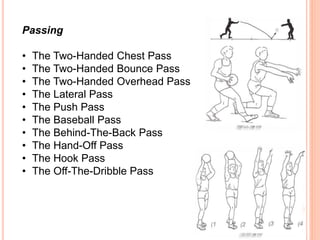Basketball
- 1. BASKETBALL Chang Qing Hong Pu Nyoke Moy Chu Rui Yee Kho Siew Ding
- 3. Main fundamental movements used in basketball ŌĆó Basic Stance ŌĆó Starting ŌĆó Stopping ŌĆó Jumping These fundamentals are needed for every aspect of basketball ŌĆó Shooting ŌĆó Passing ŌĆó Dribbling ŌĆó Defense
- 4. Basic Stance ŌĆóThe feet should be staggered and about shoulder-width apart. ŌĆóBody weight should be evenly distributed from front to back and side to side. ŌĆóThe head should be centered from front to back and side to side. ŌĆóThe arms and legs should be flexed and ready to move. ŌĆóPlayers should keep their head up. ŌĆóPlayers should stay low in their stance and be ready to move.
- 5. Starting ŌĆóPlayers should start in a basic stance. ŌĆóPlayers should be ready to move. ŌĆóThe feet should stay on the floor when starting to move. ŌĆóThe weight should shift in the direction of the movement. ŌĆóThe head should move first in the direction of the movement. ŌĆóPlayers should stay low and move quickly when starting a move. ŌĆóStarts should be made in a straight line.
- 6. Pivoting ŌĆóPlayers should start in a basic stance. ŌĆóPlayers should be ready to move. ŌĆóThe feet should be wide apart. ŌĆóThe head should be level. ŌĆóPlayers should be in good balance and keep their head up. ŌĆóPivoting should be done quickly and with a specific purpose.
- 7. Stopping ŌĆóWhen using the quick stop, players should jump from one foot and land on two feet. ŌĆóPlayers should land in a basic position and be ready. ŌĆóPlayers should stay close to the floor. ŌĆóThe quick stop is used to get into the basic position needed to dribble, pass and shoot. ŌĆóWhen using the stride stop, players should stay low. ŌĆóPlayers should land on their back foot first, and then on their front foot. ŌĆóThe stride stop is used to change directions when running.
- 8. Jumping ŌĆóPlayers should be in a basic position and be ready to jump. ŌĆóPlayers should jump under control and then land in a basic position. ŌĆóPlayers should jump off of one foot when they want to jump quicker and higher - when shooting lay-ups for example. ŌĆóPlayers should jump off of two feet when they want to jump with more power and control - when rebounding for example. ŌĆóPlayers should use quick stops and quick jumps when shooting jump shots.
- 9. Shooting ŌĆó Mental: ’āś Concentration ’āś confidence ŌĆó Physical ’āś Sighting or locating the target ’āś Body Balance ’āś Generating the force ŌĆó Keep your feet, head, and shoulders square to the basket on your shot. Don't turn them to the side. ŌĆó Jump straight up on your jump shots. You should avoid fading away or floating to the side. ŌĆó Keep your elbow under/behind the ball as you are preparing to shoot. ŌĆó Your free-throw routine should be simple. This helps you concentrate more on your shot and not your routine.
- 11. Dribbling ŌĆó Knees bent, back straight, head up, protection arm (or non-dribbling arm) up. ŌĆó Use finger tip control with a loose wrist. ŌĆó Keep your dribble low - avoid dribbling above your waist. ŌĆó Look at the basket, but see the whole court. This increases your court vision and makes you more of an offensive threat. ŌĆó Don't dribble to advance the ball up the court when an open pass to a teammate is available. ŌĆó Don't dribble too soon upon receiving the ball. First look for an open teammate, if no pass is available - then use your dribble.
- 12. Passing ŌĆó The Two-Handed Chest Pass ŌĆó The Two-Handed Bounce Pass ŌĆó The Two-Handed Overhead Pass ŌĆó The Lateral Pass ŌĆó The Push Pass ŌĆó The Baseball Pass ŌĆó The Behind-The-Back Pass ŌĆó The Hand-Off Pass ŌĆó The Hook Pass ŌĆó The Off-The-Dribble Pass
- 13. Defense ŌĆó Stay low. Your feet should be shoulder-width apart. Your hands should be up and out at 45 degrees about chest height. ŌĆó Force your opponent out of the middle and to the side. This is done by playing slightly to one side of them. ŌĆó Put a hand up in front of your players face to obstruct a good view of the basket. ŌĆó Keep your hands straight up when defending the post from behind.
- 16. Name: Dr. James Naismith Job:Guru olahraga YMCA Date :15 Desember 1891. Place : Springfield, Massachusetts
- 17. Naismith (Kanada) diberi tugas membuat suatu permainan di ruang tertutup untuk mengisi waktu para siswa pada masa liburan musim dingin di New England. Terinspirasi daripada permainan yang pernah beliau mainkan saat kecil di Ontario, Naismith menciptakan basketball. Menurut cerita, setelah menolak beberapa gagasan kerana dianggap
- 18. terlalu keras dan kurang cocok untuk dimainkan di gelanggang-gelanggang tertutup, beliau lalu menulis beberapa peraturan dasar, menampalkan sebuah keranjang di dinding ruang gelanggang olahraga, dan meminta para siswa untuk mulai memainkan permainan ciptaannya itu. Pertandingan resmi pertama berlangsung pada 20 Jan 1892 di YMCA
- 19. Pada awalnya, setiap tim berjumlah sembilan orang dan tidak ada dribble, sehingga bola hanya dapat berpindah melalui lemparan. Sejarah peraturan permainan basket diawali dari 13 aturan dasar yang ditulis sendiri oleh James Naismith.



















